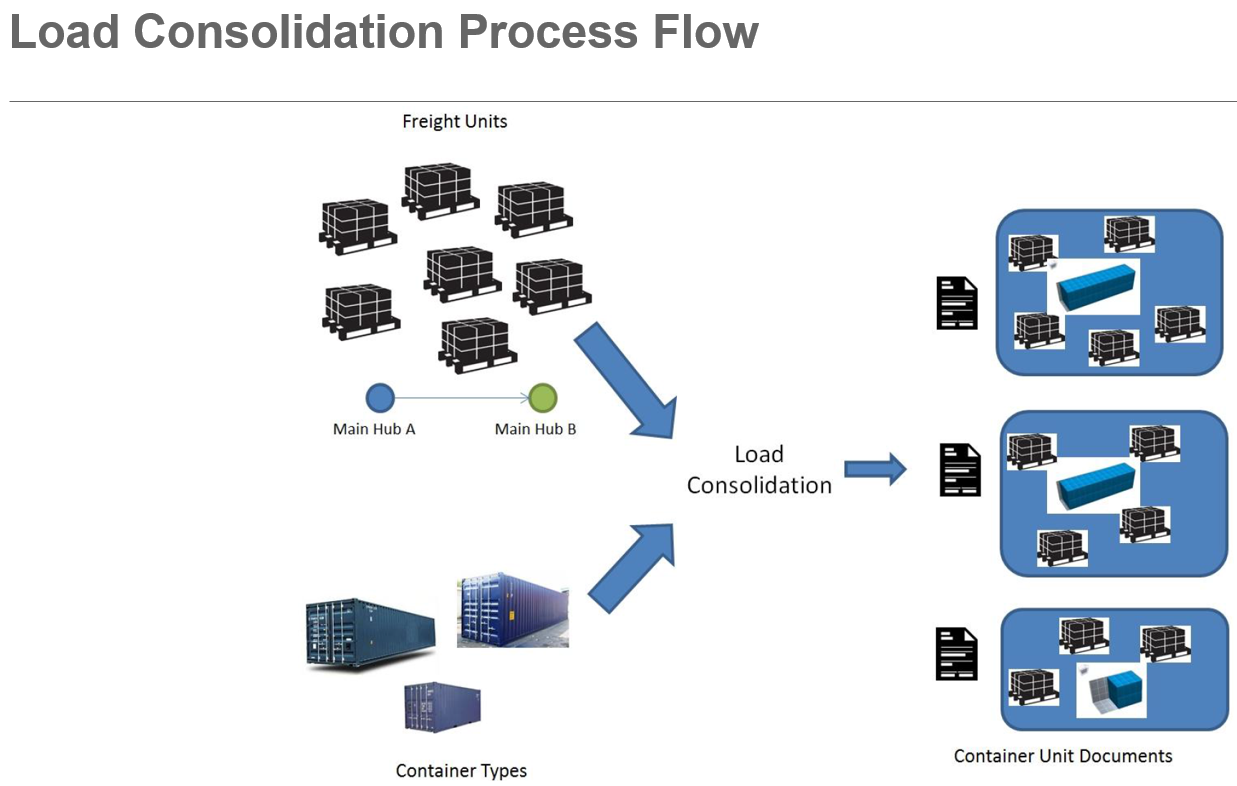
- SAP Community
- Products and Technology
- Supply Chain Management
- SCM Blogs by SAP
- Monday Knowledge Snippet (MKS) - 65 TM 9.4 Load Co...
Supply Chain Management Blogs by SAP
Expand your SAP SCM knowledge and stay informed about supply chain management technology and solutions with blog posts by SAP. Follow and stay connected.
Turn on suggestions
Auto-suggest helps you quickly narrow down your search results by suggesting possible matches as you type.
Showing results for
former_member18
Active Contributor
Options
- Subscribe to RSS Feed
- Mark as New
- Mark as Read
- Bookmark
- Subscribe
- Printer Friendly Page
- Report Inappropriate Content
11-14-2016
3:59 PM
As a continuation of the SAP Transportation Management Load Planning journey, the just released TM 9.4 adds the new feature of Load Consolidation. Remember, back with TM 9.1 Load Planning was introduced (MKS37). With this, it is possible to do automated load planning for Freight Orders and Container Units determining the load sequence of the goods considering the resource constraints and loading rules. Combined with the neat 3-D visualization using SAP Visual Business, already a good share of LP relevant scenarios can be tackled.

The following releases saw scenario improvements with a growing number of supported rules. TM 9.3 added the feature of package building (MKS53) to close the gap between orders based on products and load planning happening on pallets / packages.

The new Load Consolidation basically turns the table of the load planning process. The feature takes a set of transportation demands and resource types and determines the most cost efficient combination. The feature is meant to be used for main stages with a high transportation volume. For example you have multiple transports going from port Hamburg to port Newark and you have multiple different container types at hand (of course with different cost attached), TM 9.4 Load Consolidation will first try to use the cheapest container type. This includes the consideration of incompatibilities when some goods require specific resources.

From the user perspective, the function is executed in the Transportation Cockpit:

On the top left, the Freight Units going from Mannheim to Chicago are selected and on the bottom left you can see the containers. Of course it is possible to limit the number of available containers per type.

After executing the function, you can see the result on the top right represented by container units.
Load Consolidation can be executed considering all Load Planning relevant rules, or in a simple mode just based on capacity.
We think that Load Consolidation improves the planning of main stages significantly. In the next weeks I will go a bit more into detail.
As ever when presenting a new feature, feedback is very wellcome.

The following releases saw scenario improvements with a growing number of supported rules. TM 9.3 added the feature of package building (MKS53) to close the gap between orders based on products and load planning happening on pallets / packages.

The new Load Consolidation basically turns the table of the load planning process. The feature takes a set of transportation demands and resource types and determines the most cost efficient combination. The feature is meant to be used for main stages with a high transportation volume. For example you have multiple transports going from port Hamburg to port Newark and you have multiple different container types at hand (of course with different cost attached), TM 9.4 Load Consolidation will first try to use the cheapest container type. This includes the consideration of incompatibilities when some goods require specific resources.

From the user perspective, the function is executed in the Transportation Cockpit:

On the top left, the Freight Units going from Mannheim to Chicago are selected and on the bottom left you can see the containers. Of course it is possible to limit the number of available containers per type.

After executing the function, you can see the result on the top right represented by container units.
Load Consolidation can be executed considering all Load Planning relevant rules, or in a simple mode just based on capacity.
We think that Load Consolidation improves the planning of main stages significantly. In the next weeks I will go a bit more into detail.
As ever when presenting a new feature, feedback is very wellcome.
- SAP Managed Tags:
- SAP Transportation Management,
- SAP Visual Business
4 Comments
You must be a registered user to add a comment. If you've already registered, sign in. Otherwise, register and sign in.
Labels in this area
-
Business Trends
169 -
Business Trends
23 -
Catalog Enablement
1 -
Event Information
47 -
Event Information
4 -
Expert Insights
12 -
Expert Insights
38 -
intelligent asset management
1 -
Life at SAP
63 -
Product Updates
500 -
Product Updates
65 -
Release Announcement
1 -
SAP Digital Manufacturing for execution
1 -
Super Bowl
1 -
Supply Chain
1 -
Sustainability
1 -
Swifties
1 -
Technology Updates
187 -
Technology Updates
17
Related Content
- Automatic Freight Unit Planning in Supply Chain Management Blogs by SAP
- Automated Yard Processes using TinyML - 2 of 2 in Supply Chain Management Blogs by SAP
- Details Map Route - TM in Supply Chain Management Q&A
- Tuesday Knowledge Snippet Series in Supply Chain Management Blogs by SAP
- Tuesday Knowlegde Snippet Series Prelude in Supply Chain Management Blogs by SAP
Top kudoed authors
| User | Count |
|---|---|
| 9 | |
| 8 | |
| 6 | |
| 4 | |
| 3 | |
| 3 | |
| 3 | |
| 3 | |
| 3 | |
| 3 |